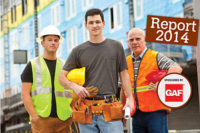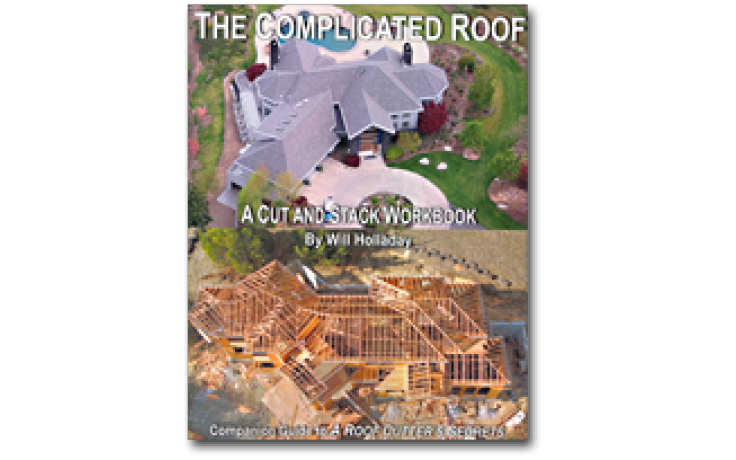2014 State of the Industry Report: Market Outlook
Opportunities and Challenges Both Loom Large in 2014








































As part of the State of the Industry Report, Roofing Contractor asked a variety of roofing professionals, industry insiders, economists and other experts to share their insights on the economic outlook for the year ahead and key trends to keep an eye on. We also asked them to identify the major challenges facing the industry and how contractors could prepare to meet them as the year progressed.
We’d like to thank the contractors, manufacturers, distributors, industry association officers and others who shared their perspectives with us in the State of the Industry Report, which is sponsored by GAF.
| State of the Industry Reports | |||
The U.S. Construction Market
Economists are cautiously optimistic about growth in the domestic construction market and the roofing segment in particular going into 2014. Looking back at last year, Randy Giggard, managing director of research services for FMI Corporation, outlined some of the challenges of 2013 before noting a few bright spots. “Throughout 2013, the U.S. construction market was impacted by the confusion of mixed signals,” he said. “Concern over the impact of the Affordable Care Act was exacerbated by a botched Web launch. Federal sequestration impacted public construction and jobs. The unemployment rate fell, but a deeper look reveals that many people just stopped looking and that many of the jobs created are at lower wage rates. Inflation remains low, but there is great concern for where it goes as the Federal Reserve stops pumping money into the economy. Moreover, we experienced an economy showing slow, cautious improvement, but lacking any real enthusiasm.”
|
Robert Tafaro: Our Progress, Challenges and the Trends Ahead |
|
2013 was a year of progress for the roofing industry, but it was one that never quite delivered on its initial promise. We realized an increase in housing starts, continued strong demand from emerging trends such as sustainable roofing and a growing interest in TPO. Yet the optimism we had when the year began for increased demand faded when we faced challenges such as continued economic pressures and low storm demand. Here are some of the factors affecting our industry’s performance in 2013 — and our forecast for how those same factors may affect us in 2014: Absence of storms. Only two hurricanes reached Category 1 on land, and there were no Category 2 or greater hurricanes in the Atlantic. In fact, the year ranks as the 7th quietest season in the past 70 years. This is unlikely to be repeated in 2014 and, while roofing demand is always hard to predict, we are cautiously optimistic for the year ahead. Unbalanced shipments. In 2012, a disproportionate share of the business shipped to distributors in the first half of the year. While we saw an improvement in 2013, shipments still were overly weighted to the first half. Fortunately, we expect shipments to be more balanced from quarter to quarter in 2014. Raw materials costs. Availability and quality of asphalt continued to be a challenge; the closure of additional refineries in the United States and the continued decline of gasoline demand have further reduced the supply of asphalt. Expensive oxidation processes are now required to ensure asphalt quality. These factors will continue to put pressure on overall roofing costs in 2014 and beyond. Other polymers, including polypropylene and PVC, are also seeing cost increases, which will put pressure on commercial roofing costs. Residential improvement, commercial decline. In 2013, we experienced a modest but sustained macroeconomic and building materials environment. Annual home starts increased from 780,000 in 2012 to approximately 890,000, and are forecasted to rise to 1 million for 2014 and 1.12 million for 2015, toward the 1.5 million historical average. In commercial, there was a decline in public projects due to the lack of federal and state funding, which will likely continue. Despite the challenges, some positive emerging trends should favorably affect demand this year and into the future. In the residential housing market, for example, rising home prices, reselling activity and an ease in the pace of foreclosures already have contributed to a surge in remodeling. Rising interest rates and cautious mortgage lending practices could temper the surge, but the net effect still should be positive. Another trend is a growing interest in sustainability. In 2013, we saw continued activity from architects in navigating the new LEED v4 requirements, and we expect this to accelerate in 2014. LEED v4 requires third-party validation of sustainability claims and designations for products specified in LEED buildings. Contractors and architects are educating themselves and are beginning to adopt products that have been validated with the emerging sustainability designations, such as the Health Product Declaration (HPD) or Environmental Product Declaration (EPD). Greater commercial interest in sustainability is matched on the residential side of the business by homeowners who want the right style of shingle to match their home’s exterior. Demand for designer collection shingles continues to grow, as does the importance of differentiation in shape and color for shingle products. Homeowners expect a solution that not only performs but also meets their personal taste and style — and we know how to turn those dreams into reality. Furthermore, this shift has put pressure on the contractor to develop a more sophisticated in-home selling presentation, which led to an increase in the adoption of digital technology and business-building programs in the roofing industry. In 2014, 81 percent of contractors expect to focus more on in-home selling, and the most forward-thinking contractors are using apps and other technology to enhance the in-home selling process. While 75 percent of contractors still rely on paper or a Microsoft Word or Excel file to develop estimates, many will begin exploring technology solutions to enhance this process. Looking past 2014, we expect growth in manufacturing capacity, stronger criteria for shingle performance and testing, and a greater emphasis on technology in managing sales and installations: The next few years will be characterized by investment in commercial and residential roofing plants by several manufacturers. Many of these investments reflect the continued growth of single ply at the expense of asphaltic systems, with TPO growing strongly and PVC holding steady. GAF has led investment to meet this demand shift, and is currently in the process of planning a fourth TPO plant and fourth ISO plant in the Northeast. In residential, plans are underway for our state-of-the-art four-wide laminator, which will be the highest-capacity laminator in the industry. These new manufacturing capabilities will put GAF in a strong position to meet not only the code requirements of today but also those of the future. Indeed, 2014 will be a key year for codes. The most significant residential code change has been the emergence of ICC’s AC 438 acceptance criteria for shingles. AC 438 is a new standard in codes that is performance based and not prescriptive on the ingredients of a shingle. It is also the first standard for asphalt shingles that tests the performance of the shingle after accelerated aging as opposed to the time of manufacture, which puts a greater focus on longer-term, “real-world” performance of products. This acceptance criterion allows the roofing industry to take advantage of advancements in material science and opens the door for many new product innovations. In commercial, this realism is reflected in new PIMA testing requirements that have revised the Long-term Thermal Resistance (LTTR) value. In 2014, the commercial roofing industry will be focused on communicating the new measurement system, which has not been adopted by other insulations. With these changes, polyiso still continues to offer the highest R-value per inch of any rigid foam insulation product available. We also expect the emergence of technology solutions that help navigate insurance claims, such as those by Accurence. Similarly, many commercial contractors have also adopted technology to help them run their businesses and are managing sales and installations with increasingly sophisticated systems. Given that 80 percent of consumers begin their buying process with a web search, all players in the roofing industry — like any other industry — must continue to focus on maximizing their search engine traffic as well as their overall online presence. The good news is that one thing never changes, and that’s our industry’s commitment to adding value for our customers. Both residential and commercial roofing contractors continue searching for and adopting business-building solutions to add value to our products and services. An example of this is maintenance programs, which commercial contractors started adding a few years ago but apply to both sides of the business. At the same time, roof asset management software solutions are increasingly adopted as a means for contractors to better manage their businesses, as well as to transparently communicate to building owners and facility managers what roofing projects have been completed and where. Contractors who want to stay ahead of the curve should consider partnering with a manufacturer who can help them navigate this new world with reliable support in leads, technology and education. These industry trends mean significant changes — making it even more important that we look for ways to simplify existing processes. At GAF, for example, we are restructuring our commercial guarantees and rolling out a more simplified program to give our customers the increased options and greater transparency they seek. Roofing demand is always hard to predict and, like many other industries, we face numerous changes and challenges. However, by continuing to harness innovation, embrace and maximize technology, and collectively focus on providing value, we can all maximize whatever demand comes our way. Robert Tafaro is CEO of GAF. |
“There are exceptions,” he continued. “New single-family and multifamily residential construction volume put in place was up 28 percent and 38 percent respectively. The cyclical lodging segment continued to improve with a gain of 15 percent. And geographic pockets such as New York City, San Francisco and the state of Texas were very active. Tremendous investment in the U.S. oil and gas sector promises low-cost energy in the United States that will significantly impact the broader economy and support the on-shoring of heavy manufacturing back to the United States.”
Giggard sees continued improvement this year. “In the near term, we anticipate that 2014 will be a year of continuing slow, steady improvement with some modest acceleration,” he said. “The residential sector and lodging segment will continue to show double-digit growth. The commercial segment will expand by 5 percent. The large education and health care segments will again begin to expand, each at annual rates of 4 percent. Total U.S. construction volume will gain 7 percent in 2014, about the same percentage improvement as 2013, but with a heavier concentration of gains in the nonresidential buildings segments. This level of steady growth is not necessarily a bad thing. Remembering that we drove two million workers out of the industry during the downturn, steady growth can avoid undo pressure on available labor and material resources.”
Matt Zielenski, industry analyst for The Freedonia Group, expects the U.S. construction market will see favorable growth in 2014. “The residential market will probably see the more rapid gains,” he said. “New housing activity will continue to rebound, which will be a key impetus for growth. If home values continue to rebound and banks loosen lending requirements, we could see an uptick in home improvement spending as more homeowners will be able to take out home equity loans.”
“In the nonresidential market, you will see steady increases in construction spending,” he continued. “Rising consumer confidence will boost construction of malls and retail sites, while office construction will see good growth as more high rises and office complexes are erected. The manufacturing segment will continue to see gains. Natural gas prices are forecast to remain low, which will encourage re-shoring. Manufacturers will return plants to the United States or expand existing sites. This increase in domestic production will also support the construction of such buildings as warehouses and distribution centers.”
Zielenski expects “highly favorable growth” in roofing demand for 2014. “Increasing new housing construction activity will be the primary driver of demand — all of these newly built homes will require roofing,” he noted. “Houses will also be slightly larger, on average, so more squares of roofing will be needed per unit. Similarly, growth in nonresidential building construction will promote demand for roofing. The office and commercial health care and industrial segments will see some of the strongest advances.”
“Metal roofing demand will continue to advance,” he continued. “It is durable, it doesn’t require much maintenance, and most metal materials qualify for LEED. Metal roofing is often specified on manufacturing plants and warehouses, and those segments will see strong growth as U.S. manufacturing rises. You will also see rising demand for prefabricated metal buildings, all of which have metal panel roofing. Insulated modules will see strong growth — businesses need to conserve energy.”
One factor that cannot be predicted is storm damage, Zielenski noted. “If 2014 is fairly quiet, that will serve to tamp down growth rates,” he said.
Roofing Outlook
Brian Chambers, vice president and general manager, roofing and asphalt for Owens Corning, sees signs that the residential roofing market is on the upswing in 2014. “Our outlook for the residential roofing market is that new construction will continue its upward trajectory driven by increasing housing prices, low mortgage rates, increasing rates of household formation and rising rents in many markets,” he said. “We also feel that it is reasonable to think that re-roof demand would gradually increase in the coming year after pulling back a bit in 2013. While storms are notoriously difficult to predict, if the storm season is similar to 2013 or slightly more active, we may see some additional recovery in demand for the market.”
Bob Wamboldt, senior vice president and general manager, roofing systems for Johns Manville, looks for modest growth in the commercial sector. “The Federal Reserve forecasts overall gross domestic product growth of 2.9 percent to 3.1 percent,” he said. “Forbes magazine also echoes this growth projection, landing on a 2.9 percent rate. We at Johns Manville anticipate a positive change in the range of 2-3 percent in overall commercial roofing squares. This will be due to growth in the private sector, offsetting the continued weakness in the public sector. Berkshire Hathaway owns subsidiaries that depend on construction activity, so we would characterize our outlook as having a strong long-term holding position.”
John McLaughlin, president, exterior products for Allied Building Products, looks for slight improvement for the roofing industry overall in 2014, but cautioned that a lot depends on storm activity. “Housing starts will begin inching up, and baseline business will be up. Storm activity will determine ultimately how much it rises,” he said. “There is pent-up demand in the steep-slope market contractors can tap into, and on the low-slope side, a rough winter and a decrease in vacancies have us looking at a 3-5 percent increase. We expect metal to post continued share growth.”
Scott Lelling, senior manager, strategic marketing for Polyglass U.S.A. Inc., agrees. “Total demand for roofing products is forecasted to grow, albeit at a relatively slower pace than what was seen prior to the ‘Great Recession’ and its aftermath,” he said. “We expect demand for all roofing products to increase approximately 2.5 percent to 3.5 percent in 2014. Demand in all market segments will grow, with residential roofing products outpacing that for commercial products.”
“I expect that it will be another challenging year,” said Jay Thomas, vice president of marketing for Sika Corporation. “New nonresidential construction should be positive versus 2013, but there is still considerable uncertainty amongst building owners which is restricting capital spending for re-roofing. Everyone is challenged to deliver a good product while improving efficiency and reducing costs.”
Reed Hitchcock, executive vice president of the Asphalt Roofing Manufacturers Association (ARMA), predicts that some delayed maintenance projects will be completed in this year. “There are numerous economists forecasting construction increases in 2014, which could well translate into more dollars spent on critical maintenance to existing buildings and on new construction,” he said. “At the same time, slowly-but-surely increasing property values in many markets are likely to mean many home and building owners will have more access to money for deferred preventive maintenance and cosmetic upgrades. We remain cautiously optimistic, but given the roller coaster of recent years prudence would be to approach 2014 very conservatively.”
Dan Piché, vice president of national business development for ABC Supply Co., Inc., agrees. “As for commercial roofing, there is some pent-up demand for re-roofing and remodeling commercial projects,” he said. “However, some building owners may continue to delay work until it is critical or they begin to see positive economic trends. Expect to see private-sector work outperform public projects as a result of continuing government budget constraints.”
As the recovery takes hold nationwide, Dale Tyler, president of National Roofing Partners (NRP), expects pent-up demand for commercial repairs to be very strong. “As these national clients recover, they are finally getting the budgets they need to go and repair and maintain portfolios that are in dire need now. In 2008, 2009, 2010, they postponed hundreds of millions of dollars in repair and maintenance because they didn’t have the budgets for it. We’re finally seeing those purses open, and a lot of that repair and maintenance is just now beginning to hit the streets, and it’s substantial.”
Storm Activity
Bill Combes, director of marketing and membership for the United Association of Storm Restoration Contractors (UASRC), noted that the lack of storm activity affected the market in 2013. “We saw one of the lowest hail seasons on record, and when that happens, contractors are often lining up for hurricane work,” he said. “For 2013, we also saw a record low number of storms. We had one tropical storm affect the U.S. mainland in 2013. For contractors that depend on storms for work, it was a tough year. However, the UASRC had a great year in 2013 and grew to 38 total members. 2013 was our first complete year in business, as we were officially established in June 2012. For 2014, we remain on track to add on average two to three members per month. If it does turn out to be an above-average year for storm work, I expect we will see a higher number of members wanting to align with our organization.”
Shari Carlozzi, national sales manager, commercial roofing division for Hapco Inc., sees some positive signs in a changing landscape. “I’ve heard that the demand for commercial roofing in North America may go as high as 6.6 million square feet, which I understand may be installed through liquid and single-ply roofing applications,” she said. “Companies made money this year, although very few added any new employees. I do feel that there is some anxiety looming over the government compliance, restrictions in health care, EPA issues, etc. ‘Business as usual’ is not standard vernacular for the future.”
Dave O’Donnell, president and CEO, NEMEON Inc., also predicts moderate growth in 2014. “Exterior remodeling projects will start to increase as homeowners start to see their home values getting close to what their perceived values are,” he said. “New construction is looking like we will see an increased number of new single-family homes which will add life to the residential side of the business. Spending on commercial projects is expected to increase in 2014 as well.”
Brian Lambert, director of products and systems for The Garland Company Inc., expects modest growth for the roofing industry this year. “Certainly there will be some variability region to region — the Southeast and Southwest continue to be strong, growing markets, and we expect that to continue in 2014,” he said. “There is still some uncertainty in key new construction markets. Re-roofing and restoration projects should continue to provide solid opportunities throughout 2014.”
Richard Spanton Jr., founder and CEO of Mastercraft Exteriors, AccuLynx.com and Storm Solutions, pointed to increased lending and some state tax incentives as areas to watch. “There are more housing starts, and banks are more willing to loan businesses money compared to three or four years ago,” he said. “Also, there are a lot of states luring businesses into their markets giving tax incentives. This should mean more buildings being built and also more re-roofs for steep- and low-slope contractors as compared to 2013. I don’t think it will be a huge jump, but a moderate increase which gets us back on track as an industry.”
Ray Rosewall, president and CEO of DaVinci Roofscapes, expects his company to post double-digit sales growth in 2013 and again in 2014. “We expect sales for all of our product lines to grow in 2014,” said Rosewall. “There’s also the factor that our products meet changing codes in specific geographic areas. In some regions insurance providers offer incentives to homeowners to use our products.”
Jonathan Wierengo, vice president of marketing for The Tapco Group/Inspire Roofing Products, expects to see growth in the composite shingle market. “We believe it will be a strong year as homes are building equity again which will assist, non-storm projects. Also the average age of housing is at its oldest ever, meaning there are more homes that have aging roofs.”
Kayla Kratz, product manager for Boral Roofing, predicts resurgence in the tile roofing market. “We see an increase in roofing overall as new home construction activity increases with the improving economy,” she said. “We predict tile will increase more rapidly than other roofing materials due to builders in the Southwest, Florida and Texas building more homes with tile for its durability, aesthetics and wide selection of cool roofing colors.”
|
Chris Barrow: Leverage Technology to Increase Revenue |
|
Over the past five years, EagleView has been a part of a technology revolution within the roofing industry. As we look forward into 2014, we see that trend not only growing but creating substantial changes in how contractors run their businesses. Technology is giving contractors, distributors and manufacturers a view of day-to-day business through technology-driven data that has never been seen before. This overall view is allowing the industry to take strides forward in sales and marketing, production and warranty activities that are unprecedented. We are seeing the importance of data analysis as well. Contractors are tracking customers, closing rates and referrals in a way that has not been possible in the past. By using leading software and web services, contractors can dive into the numbers and understand where their businesses are profi table and where there needs to be improvement. Not only are they analyzing the numbers, but they can do it anywhere, anytime. The increased use of mobile devices and cloud solutions are allowing contractors to track not only numbers but relationships, employees and equipment. Information is available in real time, and successful contractors are utilizing technology constantly in order to strategize success. As seen in the State of the Industry Survey, contractors are utilizing all types of technology from social media to estimating platforms and highly powered CRM programs. The growth in the use of aerial measurements in one year is substantial and continues to grow daily. These technologies are transforming the way that contractors sell, install and maintain relationships throughout their community. With the strength of technology, contractors in 2014 will see increased productivity that will help with labor shortages and material pricing. Creating productive workflows and communications utilizing technology has clearly led to revenue increases in 2013 and will be essential to grow profitability in 2014. Chris Barrow is president and CEO of EagleView Technologies. |
Looking for a reprint of this article?
From high-res PDFs to custom plaques, order your copy today!


























